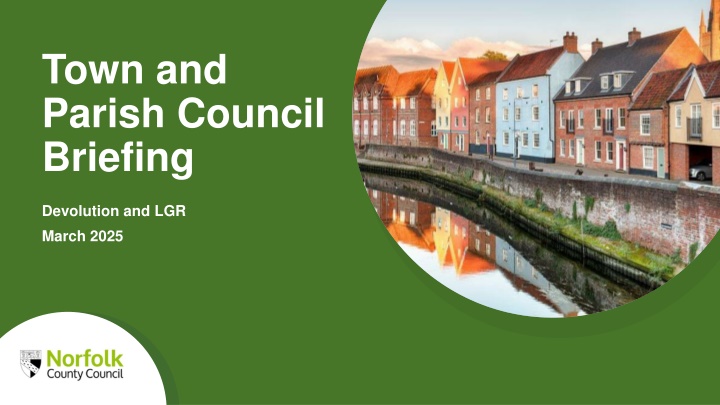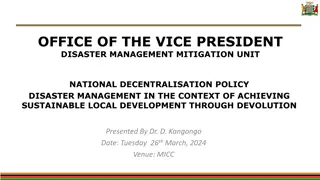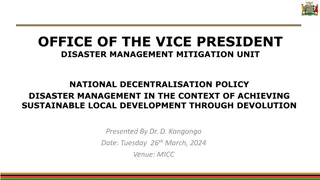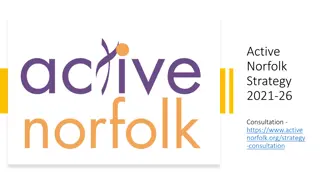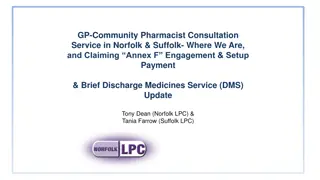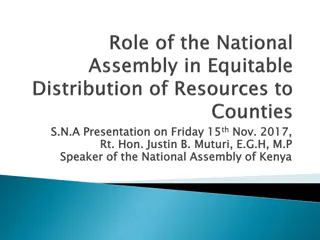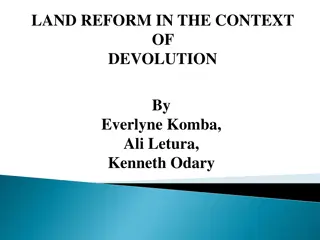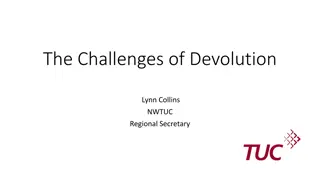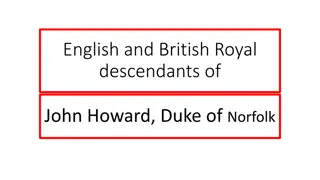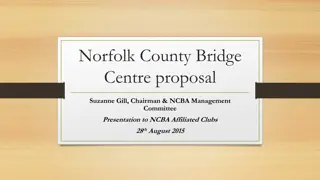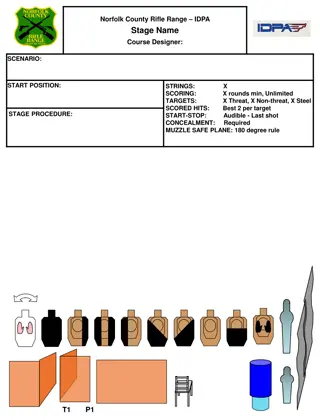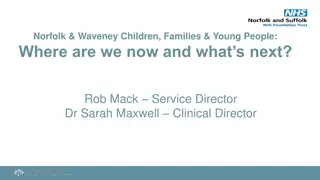Overview of Norfolk's Devolution Benefits
This briefing provides insights into the benefits of devolution through a combined authority involving Norfolk County Council and Suffolk County Council. The devolution initiative offers various advantages including a 30-year investment fund, dedicated funding pots for regeneration and retrofit projects, and enhanced collaboration opportunities. It compares this approach to a County Deal and outlines the responsibilities of the new County Combined Authority led by a Mayor. Key areas covered include transport funding, adult skills development, grant funding for regeneration projects, and the statutory role of Mayors in governing and managing transport networks.
Download Presentation

Please find below an Image/Link to download the presentation.
The content on the website is provided AS IS for your information and personal use only. It may not be sold, licensed, or shared on other websites without obtaining consent from the author.If you encounter any issues during the download, it is possible that the publisher has removed the file from their server.
You are allowed to download the files provided on this website for personal or commercial use, subject to the condition that they are used lawfully. All files are the property of their respective owners.
The content on the website is provided AS IS for your information and personal use only. It may not be sold, licensed, or shared on other websites without obtaining consent from the author.
E N D
Presentation Transcript
Town and Parish Council Briefing Devolution and LGR March 2025
Devolution The English Devolution Paper was published in December 2024 - English Devolution White Paper Mayoral devolution in areas with a population of 1.5m+. For us, this means creating a new combined authority between Norfolk County Council and Suffolk County Council. Devolution is not Local Government Reorganisation and doesn t replace, run or take over other councils. NCC applied to be part of the Devolution Priority Programme and it was announced that we have been accepted. Not all areas were. We now work towards a mayoral election in May 2026. Government has introduced the regulations to postpone NCC elections in May 2025 How might devolution through the combined authority benefit Norfolk? A 30-year investment fund. Size confirmed over the summer as part of the spending review as well as regeneration and retrofit monies. We see funding go to combined authorities as dedicated pots rather than competitive bidding Seat at the table Council of Nations and Regions; Mayoral Council
How does it compare to a County Deal? Creation of a new organisation the County Combined Authority (CCA), led by the Mayor Will move away from a Deal based approach to a framework that is automatically available when relevant criteria met. We await to see plans from government on plans for day 1 powers for us. New legislation will be introduced so that powers and funding are automatically conferred when entitled and requested Norfolk County Council and Suffolk County Council will be constituent members and ensure effective levels of collaboration and engagement across the region and partners. In the future any unitary authorities created in Norfolk and Suffolk will become the constituent members.
What is included? An Investment Fund. TBC after spending review and decisions on spend made at CCA level Transport funding routed through CCA Adult skills Fund and Skills Boot camp funding and commissioning role Grant funding for regeneration/housing - albeit successor funds to brown field and UKSPF Economic Development focus leadership of Growth Hubs for example
What else are they responsible for? New responsibilities and duties trailed in the white paper include: Transport: Mayoral Strategic Authorities will set up and coordinate a Key Route Network on behalf of the Mayor, allowing the most important local roads to be managed strategically. Mayors will hold a Power of Direction over this network to support delivery of their agreed Local Transport Plan; Regulatory power eg micro-mobility; closing roads and lane rental; A statutory role for Mayors in governing, managing, planning, and developing the rail network; Govt will consult on Taxi Licensing Joint ownership of Local Skills Improvement Plan in Norfolk, this is the Chamber of Commerce Health Mayor will chair Integrated Care Partnership, involved in appointment of ICB chair. New duty to have regard to the need to improve health, and the need to reduce health inequalities, in the exercise of their functions
Government Consultation Govt led consultation recently launched Norfolk and Suffolk Devolution Consultation - Ministry of Housing, Communities and Local Government - Citizen Space Closes 13thApril Consultation proposes governance of two representatives from each of the constituent authorities (e.g. two from Norfolk County Council and two from Suffolk County Council). Potential for four non- constituent/associate members.
Anticipated Process and Timescales Devo Feb Apr govt-led consultation Sept Feb 26 Legislative Process Feb Mar 26 New Authority Established May 26 Mayoral election Autumn Final Agreement to proceed
Local Government Reorganisation
How does Local Government Reorganisation (LGR) fit in? Policy agenda is to simplify local government, deliver financial efficiencies and improve outcomes for residents by creating unitary authorities All two-tier Councils were written to by central government, inviting proposals on 5thFebruary Interim plans to be submitted 21 March 2025. Final proposals to be submitted 26 September 2025 Decisions expected by Dec 2025-January 2026. New authorities in place by April 2028 This shouldn t just be a debate about the number but opportunity to deliver true public service reform
Government Criteria 1. Cover whole area; sensible geography and economic areas 2. Must be financially sustainable and able to withstand financial shock 3. Population guide of 500,000 or more exceptions on a case-by-case basis. 4. Deliver high quality, sustainable services. Avoid unnecessary fragmentation of services, consider impact on vital services like SEND, homelessness, social care, children's services, public safety. 5. Demonstrate joint working, local engagement. Consider local identity, cultural and historic issues. 6. Support devolution arrangements incl. population ratios. 7. Enable stronger community engagement and neighbourhood empowerment.
Key considerations for the new LGR model: Reflect the very distinct human geography of an interconnected County. Deliver the greatest level of efficiency to enable the maximum amount of resource available to reinvest in key services Deliver value for money for the taxpayer Provide clear and straightforward routes for communities to access and interact with our services Enable the views of local people to be heard Deliver clearer local accountability and democratic representation
Key considerations for the new LGR model: Be coterminous with other public agencies (notably health) to help drive wider efficiencies through whole system integration as well as supporting the Government to reform Minimise complexity, risk & disruption when having to implement changes Respect the historic and cultural fabric of Norfolk Engage and work closely with Town and Parish councils to address the needs of local communities Enable the best possible service quality and outcomes for communities. NCC will not jump to a preferred model until after more detailed evaluation over next few weeks
Initial Financial Analysis One unitary 29m 0m 29m Two unitaries 23m - 14m 9m Three unitaries 19m - 22m - 3m Annual benefit Annual disaggregation cost Recurring net annual benefit One-off transition costs - 19m - 26m - 32m Net total benefit after 5 years Payback period c 120m c 20m -c 50m Less than 1 year 3 years No payback Updated financial analysis: evaluating the importance of scale in proposals for local government reorganisation - County Councils Network Source:
Process and Timescales (Indicative at this stage) LGR Early 2026 consultation govt decision? Invitation to all councils in Norfolk March Outline Proposal Shadow elections May 27? Autumn Full Case Vesting day 1 April 28?
What about Town and Parish Councils? Coverage of a recent speech from the Minister of State: "Also speaking at the event, local government minister Jim McMahon sought to allay fears that new unitary authorities would be more remote from communities than current district authorities. He said: Every council should have a neighbourhood and localism strategy that makes sure local public services are marshalled around the people and places where they live, and for most people that's their immediate neighbourhood or district and not the council boundary in the round. The White Paper outlines "Local government plays an essential role in convening local partners around neighbourhoods to ensure that community voices are represented, and people have influence over their place and their valued community assets. We want to work with the sector to ensure that the existing structures and mechanisms for community partnership enable them to fulfil this role. We will also work with the town and parish council sector to improve engagement between them and Local Authorities." "We know people value the role of governance at the community scale and that can be a concern when local government is reorganised. We will therefore want to see stronger community arrangements when reorganisation happens in the way councils engage at a neighbourhood or area level. We will also rewire the relationship between town and parish councils and principal Local Authorities, strengthening expectations on engagement and community voice"
Working Together We will keep you updated on both devolution and LGR Please consider responding to the consultation We would be interested in hearing your thoughts on the future
